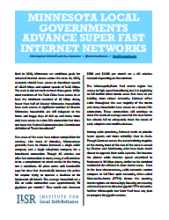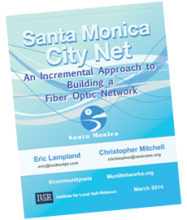
Fast, affordable Internet access for all.

Plan on spending Thursday, October 9 in Mount Vernon, Washington. Chris will speak with three other experts on creating a local environment attractive to the tech industry.
The "Connect With The World" event will occur at Skagit Valley College's MacIntyre Hall from 10 a.m. - 3:30 p.m. PDT. Other speakers will be:
Mark Anderson: One of FORTUNE's “100 Smartest People We Know,” Mark is a frequently sought after speaker around the world. His long- running weekly newsletter, Strategic News Service (SNS), counts a stellar readership, including the likes of Michael Dell, Bill Gates and Steve Ballmer.
Susannah Malarkey: Executive Director of the Technology Alliance, a statewide organization of leaders from technology businesses and research institutions dedicated to Washington’s long-term economic success.
Craig Settles: Municipal broadband expert for journalists at CNN, the Wall Street Journal, New York Times, Time Magazine and a host of business, technology and local media outlets.
Mount Vernon's municipal open access fiber network serves public entities and businesses within the City, in nearby Burlington, and in the Port Skagit area. The community began the project in 1995 and developed the network incrementally. We spoke with Kim Kleppe, Information Systems Director, and Jana Hansen, Community & Economic Development Director, in episode 38 of the Community Broadband Bits podcast.
For more on the event, contact Jana at (360)336-6214 or email her at: janah@mountvernonwa.gov.
On Monday, May 12, Westminster moved another step closer to deploying its open access citywide fiber network in Maryland. The Common Council approved a FY15 budget that includes $6.3 million for an FTTH network. The Carroll County Times reported that the $64.8 million budget was adopted 5-1. The opposing Council Member voted no on a different issue.
Last summer, the community launched two pilot projects; they installed fiber in a local retirement community and in the Westminster Technology Park. Community leaders decided to expand the pilots to the Air Business Center. They are already seeing results, with a women's fashion distribution center that decided to move from New York City to Westminster for the network.
We touched base with Dr. Robert Wack, Westminster Common Council President and the person spearheading the project. Dr. Wack told us businesses have been clamoring to get fiber service. Connectivity in the area is so bad, "they are desperate."
Community leaders want to connect 9,000 homes and 500 businesses. Dr. Wack told us the community expects to break even in 3 - 5 years; the build out should be complete in 2 years. Westminster expects to release an RFP for construction within the next week. They will release an RFP for a network operator in June.
Another Carroll County Times article described the basic plan for the project:
Westminster’s fiber network will be a “last mile” project, with the city paying to install “dark fiber” to the door of every home and business in the city and connect to the county’s fiber optic backbone, the “middle mile,” according to Wack.
Dark fiber is fiber optic cables which are connected but not in use, or “lit,” he said.

Located in rural southwest Colorado, Cortez is just 20 miles from the famous four corners of the US southwest. When incumbents were either unwilling or unable to provide modern services in the region, Cortez stepped up with a plan. This week, Cortez General Services Director Rick Smith joins us to share how they incrementally built an open access fiber network. Cortez is one of the growing number of local governments with no electric utility that has built its own fiber network - and they didn't just stop with one. They have built both a local loop for a business district and a larger regional loop to connect anchor institutions. The network was financed in large part with grants from the state that were matched locally. Cortez has plans to continue growing both networks to ensure area businesses and residents have access to the services they need in the modern economy. We covered Cortez when it first launched back in 2011 - see all our coverage here. Read more about the Cortez Community Network here.
This show is 20 minutes long and can be played on this page or via Apple Podcasts or the tool of your choice using this feed.
Transcript below.
We want your feedback and suggestions for the show-please e-mail us or leave a comment below.
Listen to other episodes here or view all episodes in our index. See other podcasts from the Institute for Local Self-Reliance here.
Thanks to Valley Lodge for the music, licensed using Creative Commons. The song is "Sweet Elizabeth."

Located just outside Washington DC, Arlington is the dense, high tech county that houses the Pentagon. This week's Community Broadband Bits podcast features Arlington County CIO Jack Belcher. Having already built a top-notch fiber network to connect community anchor institutions, the County is now preparing to improve connectivity for local businesses.
We discuss a range of topics from how local governments can take advantage of all kinds of capital projects to expand conduit and fiber assets to how Arlington County responded to 9/11 as it happened.
This show is 30 minutes long and can be played on this page or via Apple Podcasts or the tool of your choice using this feed.
Transcript below.
We want your feedback and suggestions for the show-please e-mail us or leave a comment below.
Listen to other episodes here or view all episodes in our index. See other podcasts from the Institute for Local Self-Reliance here.
Thanks to Valley Lodge for the music, licensed using Creative Commons. The song is "Sweet Elizabeth."
In a revealing video about the Internet access problem in rural Minnesota, Annandale City Administrator Kelly Hinnenkamp below describes her town's struggle with connectivity. The video is the latest in a series on the Minnesota Senate DFL YouTube page intended to shed light on the critical situation in the state.
Hinnenkamp describes broadband in the areas outside of Annadale as "horrific." She goes on to discuss how the community's poor connectivity negatively impacts its economic health. She shares a story about entrepreneurs from an artisan spice business once located in Annandale. The company started with online sales but the owners anticipated opening a storefront in the downtown area of the lake community. After contending with eight outages in three weeks, the new business pulled up stakes and moved to Buffalo.
Buffalo, located only 15 minutes away from Annandale, offers fast, reliable, affordable fiber service to local businesses.
In a February Minnesta Public Radio News article, Hinnenkamp told Dave Peters:
“Broadband is probably the single most important issue in our community right now,” she said. “Our big issue is not that we don’t have service but that we have one provider that has shown little interest in improving it. Broadband is our future."
In a Star Tribune article, Pete Kormanik, the owner of a local McDonald's, expressed his concern as a business owner:
Downloading data for a digital menu board — a task that would have taken 30 minutes at his other restaurants — dragged on for more than four hours.
After delays in processing credit cards, watching training videos and transmitting orders, Kormanik switched to an AT & T antenna. But a cloudy day can slow that service.
“If you can’t stay current with [connectivity], you’re just going to fall behind,” Kormanik said. “And businesses won’t go into those locations.”



EPB in Chattanooga offers a service to business clients that offers a good reminder that local service providers have to be able to offer a variety of business services because different businesses have vastly different wants and needs. In 2012, the publicly owned utility began offering telephone service with cloud characteristics.
The service saves money by limiting the need of small businesses to commit to capital investment and personnel costs while offering the capabilities that larger firms with larger IT staffs have. A TimesFreePress article on the service from 2012 reported:
"We looked at an average business that had nine sets and eight lines, and it comes to about $320 per month, instead of thousands of dollars in up-front costs," [Katie] Espeseth [EPB's head of product development] said.
When businesses install them on their own, the systems and devices require employees to maintain, at a time when many companies are looking to streamline their IT departments.
"It really takes the burden of installing and maintaining your telephone equipment off your own employees and puts it with our company," said Espeseth. "In Chattanooga, if a small business can take the capital they were going to spend on a new phone system and invest it in their business, it makes sense to spread that cost out over time."
EPB did their homework and now provides a service that small businesses need at affordable rates. Understanding the needs of local businesses and offering a range of options is key to the success of local providers.